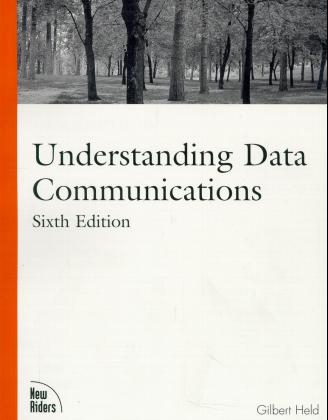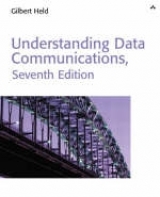
Understanding Data Communications
New Riders Publishing (Verlag)
978-0-7357-0036-9 (ISBN)
- Titel erscheint in neuer Auflage
- Artikel merken
The book explains data communications systems and their various hardware and software components. Organized like the highly successful 5th edition, the book takes a textbook approach to the complex issues surrounding the understanding of data communications concepts. This format allows the reader to tailor the book to their needs. If their objective is to obtain general information about a subject, they can bypass the more detailed portions of the text and take the quiz to test their knowledge. If they really want to delve deeper into a topic they can focus on the specifics of the chapter and refer to other books listed in the bibliography for additional information. The author provides a basis for understanding data communications systems in general, and provides expertise on setting up specific types of communications systems.
1. An Overview of Data Communications.
The Importance of Data Communications. The First Data Communications Systems. Two-State Communications Systems. Early Communications Codes. Modern Codes. Teleprinters. Data Communications in Computing. Changes in the Industries. General Description of Data Communications Systems. What You Have Learned. Quiz for Chapter 1.
2. Terminal Devices.
Teleprinters. Teleprinters Versus CRT Terminals. Serial Printers. CRT Terminals. Parts of a Terminal. PC Terminals. Data Transmission. What You Have Learned. Quiz for Chapter 2.
3. Messages and Transmission Channels.
Information as a Quantity. Bounded Medium. Unbounded Medium. Effects of Bandwidth on a Transmission Channel. Bandwidth Requirements for Signals. Carrier Systems. What You Have Learned. Quiz for Chapter 3.
4. Asynchronous Modems and Interfaces.
Why Data Can't Be Transmitted Directly. Solving the Problem with Modems. Analog Modulation. Standard Modem Features. Interface and Signaling Standards. The RS-232 and V.24 Interface. Other Interfaces. Asynchronous Modem Operations. Smart Modems. Extended Command Set Variances. Fax Modems. What You Have Learned. Quiz for Chapter 4.
5. Synchronous Modems, Digital Transmission, and Service Units.
Synchronous Signaling and Standards. Typical Synchronous Components. Standard and Evolving Modems. High-Speed Modems. Digital Transmission. The V.35 Interface. What You Have Learned. Quiz for Chapter 5.
6. Multiplexing Techniques.
Sharing a Channel. Statistical Time Division Multiplexing. Low- Speed Voice/Data Multiplexers. What You Have Learned. Quiz for Chapter 6.
7. Fiber-Optic and Satellite Communications.
Introduction and Historical Perspective. Fundamentals of Fiber- Optic Systems. Fiber-Optic Subsystems and Components. Wavelength Multiplexing. Transmission Systems. Satellite Transmission Systems. What You Have Learned. Quiz for Chapter 7.
8. Protocols and Error Control.
Protocols Versus Interfaces. Elements of a Protocol. Teletypewriter and XMODEM Protocols. Convolutional Coding-Cyclic Redundancy Checks. Half-Duplex Protocols. Full-Duplex Protocols. What You Have Learned. Quiz for Chapter 8.
9. Personal Computer Communications Software.
Communications Program Features. Dial-Up Networking. Using ProcommPlus for Windows. What You Have Learned. Quiz for Chapter 9.
10. Architectures and Packet Networks.
The Open Systems Interconnection Reference Model. Protocol Layering. Packet Networks. Advantages of Packet Switching. Packet Systems. Value-Added Services. The X Series of Recommended Standards. What You Have Learned. Quiz for Chapter 10.
11. Local Area Networks.
LAN Overview. LAN Versus Other Techniques. The Ideal LAN. LAN Standards. Ethernet (CSMA/CD). Other Ethernet Networks. Fast Ethernet. Gigabit Ethernet. Token-Passing Networks. Fiber Distributed Data Interface. Internetworking Devices. What You Have Learned. Quiz for Chapter 11.
12. Internet.
Evolution. Application Services. Internet Access Providers. IP Addressing. TCP. UDP. Serial Communications Support. Navigating the Growing Web. Security. Added Network Protection via a Firewall. What You Have Learned. Quiz for Chapter 12.
13. ISDN.
Concept. ISDN Architecture. ISDN Implementation Standards. Growth and Adaptation of ISDN. Pricing. Applications. What You Have Learned. Quiz for Chapter 13.
14. Asynchronous Transfer Mode.
Evolution. The Rationale and Underlying Technology. Architecture. Advantages of the Technology. Cell Routing. The ATM Protocol Reference Model. Service Definitions. LAN Emulation. What You Have Learned. Quiz for Chapter 14.
15. Network Design and Management.
Network Design Goals. Networking Devices. Interconnection of Networking Devices. Fault Isolation. Restoration of Service. Standards. What You Have Learned. Quiz for Chapter 15.
A. Glossary.
B. Bibliography.
C. Answers to Quizzes.
Index.
| Erscheint lt. Verlag | 17.6.1999 |
|---|---|
| Sprache | englisch |
| Maße | 179 x 229 mm |
| Gewicht | 1015 g |
| Themenwelt | Mathematik / Informatik ► Informatik ► Netzwerke |
| ISBN-10 | 0-7357-0036-2 / 0735700362 |
| ISBN-13 | 978-0-7357-0036-9 / 9780735700369 |
| Zustand | Neuware |
| Haben Sie eine Frage zum Produkt? |
aus dem Bereich



